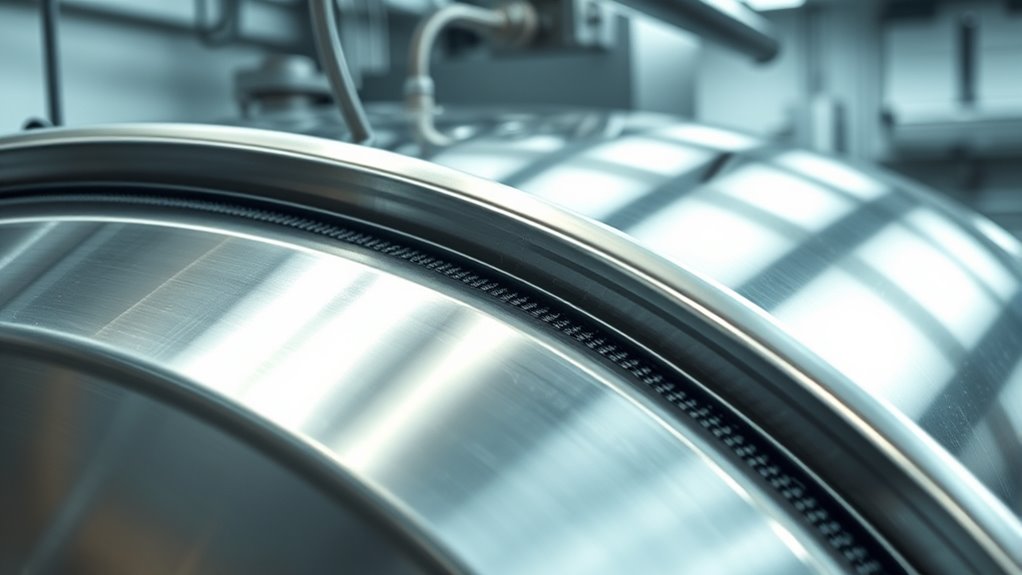To prevent channeling in media tanks, avoid common mistakes like poor tank design, using incorrect mixing equipment, and neglecting proper inlet and outlet placement. Don’t overlook internal baffles, skip regular inspections, or operate at unsuitable fill levels. Relying only on visual checks or ignoring system maintenance can lead to uneven flow and inefficiency. Proper training and monitoring are essential. Keep these points in mind, and you’ll find it easier to maintain a uniform flow, ensuring ideal system performance.
Key Takeaways
- Design tanks with proper geometry, materials, and coatings to ensure even flow and prevent dead zones.
- Use correctly selected mixing equipment and internal fittings to promote uniform media distribution and avoid stagnation.
- Properly position inlets and outlets, and maintain optimal fill levels for consistent flow and media contact.
- Conduct regular inspections, maintenance, and monitoring to identify early signs of wear or blockages that cause channeling.
- Train operators thoroughly and utilize multiple detection methods to promptly identify and address flow irregularities.
Neglecting Proper Tank Design and Geometry

Neglecting proper tank design and geometry can lead to significant channeling issues in media tanks. Your tank shape directly influences how the flow distributes throughout the vessel. If the design isn’t refined, you might notice uneven flow paths, causing some areas to experience high flow rates while others stagnate. This uneven flow can create channels, reducing mixing efficiency and risking product quality. To prevent this, choose a tank shape that promotes uniform flow distribution, such as cylindrical or conical designs, which encourage even liquid movement. Proper tank geometry ensures consistent flow patterns, minimizing dead zones and preventing channel formation. Additionally, understanding flow dynamics is essential for optimizing tank performance and maintaining uniform mixing throughout the process. Always consider flow dynamics when designing or selecting a media tank to maintain optimal mixing and process performance.
Using Inappropriate Mixing or Agitation Equipment

Choosing the wrong mixing or agitation equipment can cause uneven flow patterns that promote channeling within media tanks. If you set mixing speed too high or too low, it can create hotspots or stagnant zones, increasing the risk of channel formation. The agitation type also matters: using an incompatible style, like a paddle mixer instead of a propeller or turbine, can result in poor circulation and dead zones. Proper equipment guarantees uniform mixing, which prevents flow irregularities that lead to channeling. Always select equipment suited to your tank’s size, media type, and process needs. Adjust mixing speed carefully to maintain consistent flow without causing turbulence. Using the right agitation type and ideal speed helps maintain a homogeneous media distribution, reducing channel formation and improving overall tank efficiency. Additionally, understanding the self-watering plant pots system can help optimize the environment for root health by maintaining consistent moisture levels.
Overlooking the Importance of Proper Inlet and Outlet Placement
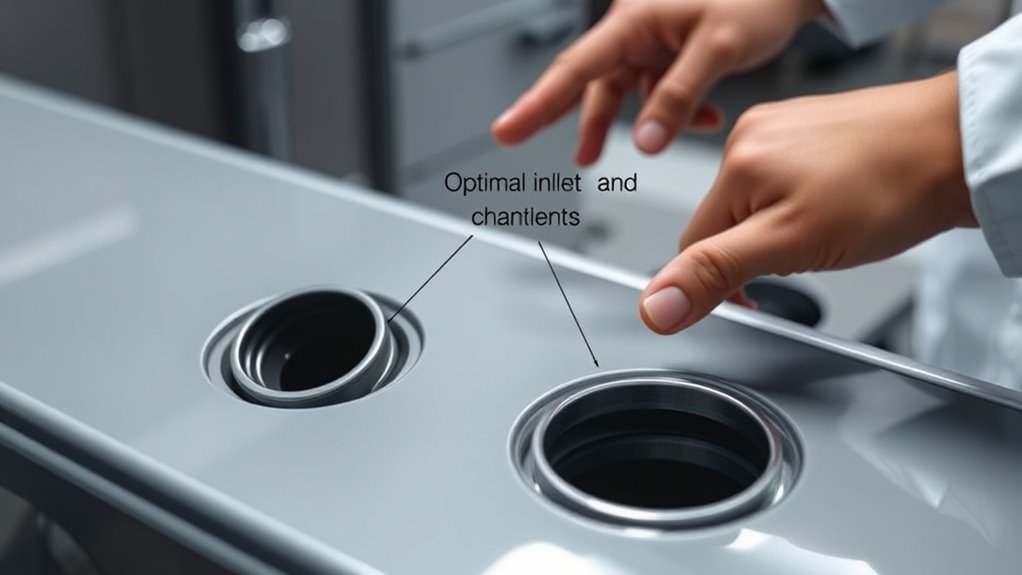
You might be surprised how much proper inlet and outlet placement affects flow patterns in your media tank. Incorrect positioning can create dead zones or channels, reducing efficiency. Ensuring ideal flow pattern and placement is key to preventing channeling and maintaining consistent treatment. Paying attention to flow dynamics during installation can prevent uneven distribution and extend the lifespan of your media.
Proper Inlet/Outlet Positioning
Proper inlet and outlet placement is crucial for preventing channeling in media tanks, as it directly influences flow patterns within the tank. Correct inlet placement ensures water enters at an ideal point, promoting even distribution and minimizing stagnant zones. Similarly, outlet positioning should be designed to draw water from various parts of the tank, preventing flow dead spots. If the inlet is too high or too low, or if the outlet is poorly positioned, flow can become uneven, creating channels that hinder filtration efficiency. You need to carefully consider how water enters and exits the tank to maintain uniform flow. Proper inlet and outlet placement help distribute flow evenly, reducing the risk of channeling and ensuring the media tank operates effectively. Additionally, understanding how flow dynamics affect media movement can further optimize tank performance.
Flow Pattern Optimization
Optimizing flow patterns within media tanks is key to preventing channeling and ensuring effective filtration. Proper inlet and outlet placement influences flow dynamics, promoting uniform water movement and reducing stagnant zones. When flow is evenly distributed, turbulence control becomes easier, minimizing dead spots that encourage channel formation. You should aim for a design that encourages consistent flow paths, avoiding sharp turns or abrupt changes that disrupt turbulence. By strategically positioning inlets and outlets, you can create a gentle, circular flow that covers the entire media bed. This approach maintains even media contact with water, prevents flow channeling, and enhances filtration efficiency. Remember, optimizing flow patterns is not just about placement but about fostering stable, controlled turbulence that keeps the entire tank active and healthy. Additionally, understanding fluid dynamics principles can aid in designing more effective flow arrangements to improve overall system performance.
Ignoring the Role of Internal Baffles and Fittings
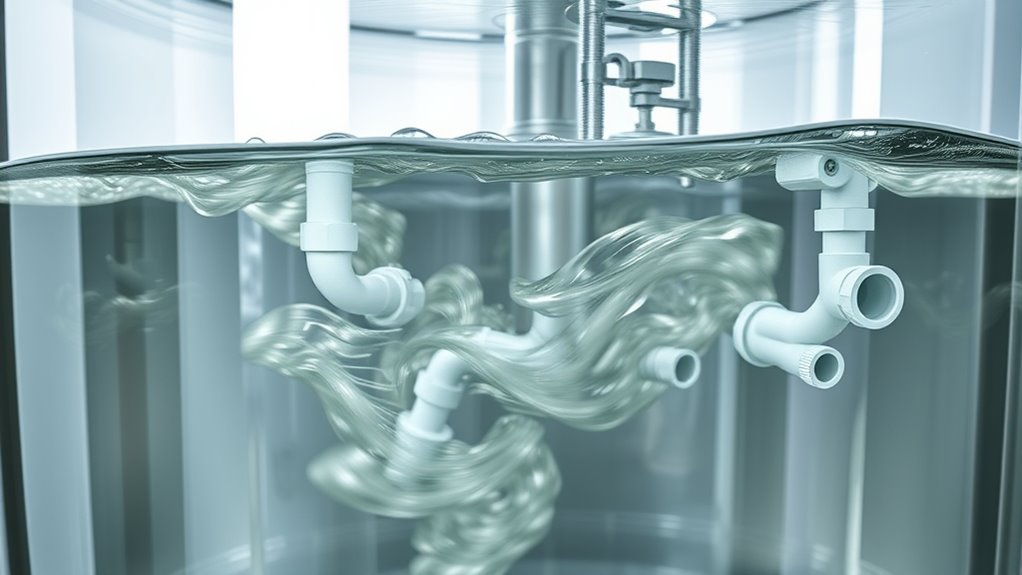
Ignoring the role of internal baffles and fittings can considerably increase the risk of channeling within media tanks. Proper internal baffles help direct flow evenly, preventing the formation of preferred pathways that create channels. Without well-designed fittings, flow can become uneven, causing stagnation or bypassing of media zones. Fittings design is critical; poorly planned fittings can disrupt flow patterns and promote channeling, reducing treatment efficiency. When you neglect these components, you risk uneven media contact and compromised system performance. Incorporating internal baffles strategically ensures uniform distribution, while carefully considered fittings design maintains consistent flow. Proper baffle placement is essential to achieving optimal flow patterns and preventing dead zones. Failing to address these elements can lead to dead zones and channel formation, ultimately undermining the tank’s effectiveness and increasing operational costs. Don’t overlook the importance of internal baffles and fittings in your tank design.
Failing to Conduct Regular Inspection and Maintenance

You need to schedule routine checks to catch issues early and prevent channeling. Regularly monitor the tank’s wear and tear to guarantee performance stays ideal. Properly maintaining alignment and other key components helps you avoid costly repairs and operational downtime. Implementing a comprehensive privacy policy ensures transparency and builds trust with users regarding data collection and cookie usage.
Schedule Routine Checks
Regularly scheduled inspections are vital for preventing channeling in media tanks, as they help identify early signs of wear, corrosion, or blockages that could compromise flow. During these checks, focus on thorough tank cleaning to remove residues that might cause uneven distribution. Proper agent selection is essential; choose cleaning agents compatible with your tank materials and media to avoid damage. Routine inspections also allow you to verify the effectiveness of your cleaning process and spot potential issues before they worsen. Incorporating Kia Tuning techniques can optimize media flow and system performance. By adhering to a consistent schedule, you guarantee your tank remains in prime condition, reducing the risk of channeling caused by buildup or corrosion. Staying proactive with inspections keeps media flow uniform and maintains the efficiency of your system.
Monitor Tank Wear
Failing to conduct regular inspections and maintenance can lead to unnoticed wear and damage in media tanks, increasing the risk of channeling and system failure. Over time, tank components may degrade due to chemical compatibility issues or temperature fluctuations, which can compromise media flow. Without proper monitoring, small cracks or corrosion can go unnoticed, causing uneven media distribution. This not only affects system efficiency but also leads to costly repairs. Regularly check for signs of wear, corrosion, and material degradation. Ensure your inspections include verifying chemical compatibility and maintaining ideal temperature control. Address issues early to prevent uneven media flow and channeling. Ignoring these signs can result in costly downtime and system breakdowns, putting your entire process at risk. Additionally, literary humor can serve as a reminder of the importance of vigilance and proactive care in maintaining system integrity.
Maintain Proper Alignment
Proper alignment of media tanks is crucial to guarantee even flow and prevent channeling, but it often gets overlooked during routine maintenance. Regular inspection should include tank calibration to ensure components stay aligned, preventing shifts that disrupt flow. Incorporate flow modeling techniques to identify potential misalignments that could cause uneven distribution. When tanks are properly aligned, material moves smoothly, reducing dead zones and channel formation. Don’t rely solely on visual checks; use precision tools to verify alignment and calibration periodically. This proactive approach ensures consistent performance and minimizes the risk of channeling. Additionally, maintaining proper alignment is essential for optimal well-being of the entire tank system, preventing unnecessary wear and tear. Maintaining proper alignment isn’t a one-time task—it requires ongoing attention to detail to keep media flowing evenly and to prolong the lifespan of your tank system.
Choosing Incorrect Tank Materials and Coatings
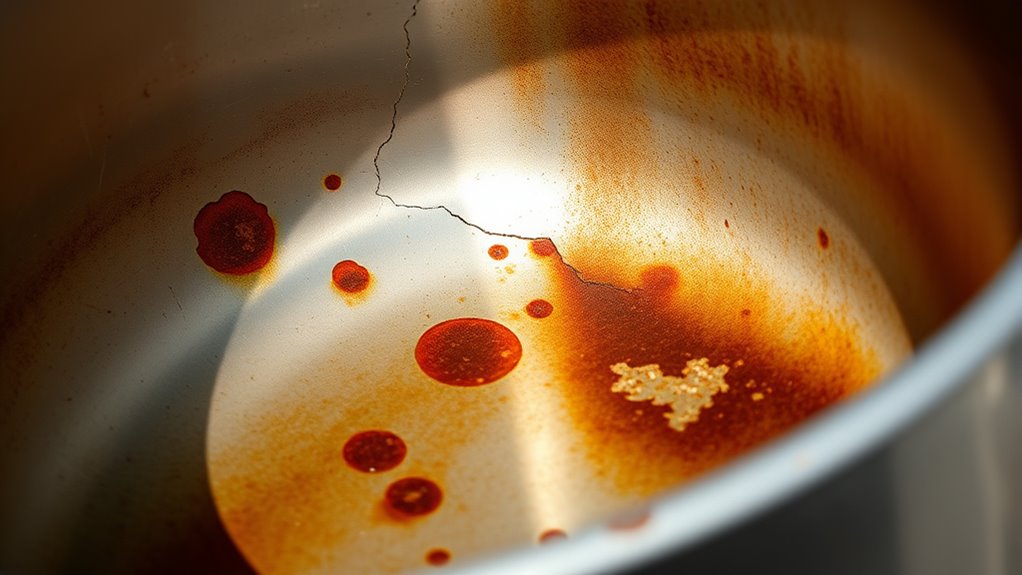
Choosing the wrong tank materials or coatings can markedly increase the risk of channeling in media tanks. Poor tank material selection may lead to corrosion, cracking, or degradation, disrupting flow and causing uneven media distribution. Inadequate coating durability can result in peeling or wear, exposing the tank to damage and contamination.
Beware of these pitfalls:
- Using incompatible materials that react with media or chemicals
- Ignoring coating durability, leading to early failure
- Overlooking long-term corrosion resistance
- Choosing cheap options that compromise tank integrity
Selecting the right tank material and durable coatings is essential. Proper tank material selection ensures longevity, while high coating durability prevents breakdowns that promote channeling. Make informed choices to keep media flowing smoothly and avoid costly repairs.
Operating at Improper Fill Levels
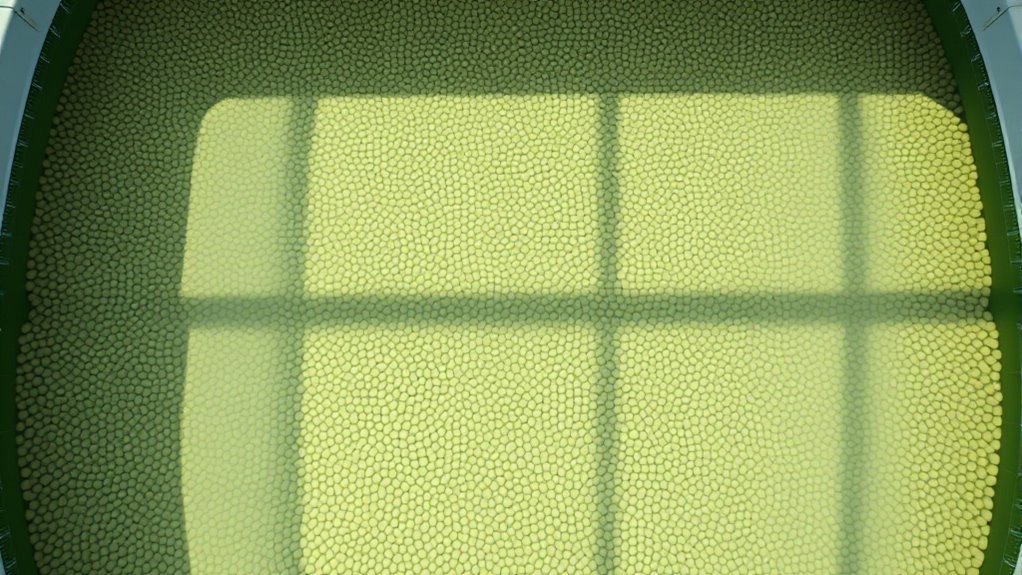
You need to maintain ideal fill levels to prevent channeling and guarantee proper media flow. Overfilling tanks can cause uneven distribution and damage, while underfilling may lead to poor contact with the media. Regularly monitor level indicators to keep fill levels within the recommended range and avoid operational issues.
Maintain Optimal Fill Levels
Operating the media tank at incorrect fill levels can substantially increase the risk of channeling, which hampers efficient flow and reduces contact time. When levels are too low, agitation speed can become uneven, leading to dead zones. Overfilled tanks restrict proper chemical dosing, causing uneven treatment. Maintaining ideal fill levels ensures consistent agitation, promotes uniform flow, and maximizes contact time. It also helps prevent clogging and uneven distribution, critical for effective treatment.
Be aware of these risks:
- Feel the frustration of ineffective treatment due to poor flow
- Avoid costly downtime caused by uneven agitation
- Prevent chemical wastage from improper dosing
- Protect your system from damage caused by improper fill levels
Avoid Overfilling Tanks
Overfilling media tanks can lead to serious issues like channeling, uneven flow, and increased pressure that stress the system. To avoid this, you must operate within the tank volume limits. Overfilling hampers proper media distribution and can trigger overflow, risking damage and contamination. Implementing overflow prevention measures ensures the tank stays within safe levels. Use accurate level indicators and control devices to maintain ideal fill levels. Properly managing tank volume reduces the risk of channeling and maintains consistent flow. Regularly check your tanks to prevent overfilling and guarantee system longevity. Here’s a helpful overview:
| Tank Volume (gallons) | Fill Level (%) | Overflow Prevention Method |
|---|---|---|
| 0–75 | 25–75 | Level sensors |
| 76–90 | 75–90 | Overflow alarms |
| 91–100 | 90–100 | Automatic shutoff |
| 101–120 | 100+ | Emergency drain |
| 121+ | N/A | Regular inspections |
Monitor Level Indicators
Monitoring level indicators is essential to maintaining proper fill levels and preventing issues like channeling. When your sensors are properly calibrated, you get accurate readings that help you avoid overfilling or underfilling your media tank. This precision reduces the risk of leaks and ensures consistent operation. Regularly check and calibrate sensors to keep them reliable. Proper monitoring also helps you detect problems early, saving costly repairs and downtime. Staying vigilant with level indicators keeps your tank functioning efficiently and safely.
- Feel confident knowing your media levels are precise, reducing costly mistakes.
- Prevent leaks before they happen, saving you time and money.
- Achieve peace of mind with accurate sensor calibration.
- Maintain smooth operations and avoid channeling caused by improper fill levels.
Relying Solely on Visual Observation to Detect Channeling

While visual observation is a common method for detecting channeling in media tanks, relying solely on it can be misleading. Visual cues like uneven flow or stagnant areas might not always be apparent. Color changes, for instance, can indicate flow issues but may be subtle or delayed. To improve detection, consider these factors:
| Observation Method | Limitations |
|---|---|
| Visual cues (flow patterns) | Might miss hidden or slow-moving channels |
| Color changes | Can be subtle and affected by lighting |
| Sensor data | Provides objective, real-time info |
| Pressure readings | Detects flow restrictions indirectly |
| Tank sampling | Confirms flow uniformity through analysis |
Relying solely on visual cues and color changes risks overlooking hidden channeling, so combine methods for accuracy.
Neglecting to Adjust for Viscosity and Density Variations

Failing to adjust for viscosity and density changes can substantially impair the effectiveness of media tank operations. When you neglect proper viscosity measurement and density adjustment, you risk uneven media flow, increased channeling, and reduced filtration efficiency. Changes in temperature or fluid composition can alter these properties, making your system less effective if unaddressed.
Neglecting viscosity and density adjustments can compromise media tank efficiency and lead to costly issues.
Be aware of these critical issues:
- Unexpected blockages that cause costly downtime
- Reduced filtration performance risking contamination
- Inconsistent media flow leading to uneven treatment
- Increased maintenance costs due to preventable wear
Skipping Proper Training and Operator Education

Skipping proper training and operator education can lead to costly mistakes and system inefficiencies. Without thorough training, you risk falling into training complacency, where assumptions replace understanding, increasing the chance of operator miscommunication. This can cause improper tank operation, leading to channeling issues and uneven media flow. To avoid this, guarantee your team is well-educated on media tank dynamics and proper procedures. Here’s a quick overview:
| Key Focus | Impact of Skipping Training |
|---|---|
| Training Complacency | Reduced awareness causes mistakes in operation |
| Operator Miscommunication | Leads to incorrect adjustments and settings |
| Proper Technique | Ensures even media distribution and flow |
| Regular Education | Keeps operators updated and vigilant |
| Clear Communication | Prevents misunderstandings and errors |
Frequently Asked Questions
How Does Temperature Fluctuation Impact Channeling Prevention?
Temperature fluctuations can considerably impact channeling prevention by causing thermal expansion and creating temperature gradients within the media tank. When temperatures rise and fall, the media expands and contracts, potentially forming gaps or uneven flow paths. You need to monitor and control temperature variations to minimize these effects, ensuring consistent media flow. Proper insulation and temperature regulation help maintain uniform conditions, preventing channeling caused by unpredictable thermal expansion and gradients.
Can External Environmental Conditions Influence Tank Channeling?
Think of external environmental conditions as the wind shaping a stream’s course. Yes, external vibrations and atmospheric pressure can influence tank channeling by causing movement or instability inside the media. These forces may create uneven flow paths, risking blockages or uneven distribution. To maintain smooth flow, you need to monitor and mitigate these external factors, ensuring your media tank remains a steady river, undisturbed by outside forces.
What Role Does Fluid Chemistry Play in Channeling Risks?
Fluid chemistry markedly impacts channeling risks because fluid composition and chemical reactivity influence how media settles and interacts within the tank. If your fluid contains reactive chemicals or unevenly mixed components, it can cause uneven flow paths, increasing the chance of channel formation. By monitoring and controlling fluid chemistry, you reduce these risks, ensuring a more uniform media distribution and minimizing the chances of channeling occurring in your tank.
Are There Specific Industry Standards for Tank Design to Prevent Channeling?
You’ll find that industry standards for tank design focus on minimizing channeling through proper tank insulation and effective maintenance protocols. These standards often specify features like agitation systems, baffles, and insulation to promote uniform media flow. When you follow these guidelines, you reduce the risk of channeling, ensuring consistent processing. Regular maintenance keeps the tank’s internal components in top condition, helping prevent flow disruptions and maintaining ideal operation.
How Does Flow Rate Variation Affect the Development of Channeling?
Flow rate variation can markedly impact channeling development by disrupting flow consistency and pressure stability. When flow rates fluctuate, uneven media movement occurs, creating pathways and weak spots that encourage channel formation. To prevent this, you should maintain steady flow rates and pressure levels, ensuring consistent media distribution. This approach helps stabilize the media, minimizes channeling risks, and promotes efficient tank operation.
Conclusion
By avoiding these common mistakes, you can prevent channeling in media tanks like a skilled navigator steering clear of hidden reefs. Regular inspections, proper design, and operator training keep your tank functioning smoothly, ensuring consistent flow and peak performance. Don’t let neglect turn your tank into a maze; stay vigilant and proactive. Think of it like tending a garden—you’ll enjoy healthy, trouble-free operation when you give it the right care and attention.
